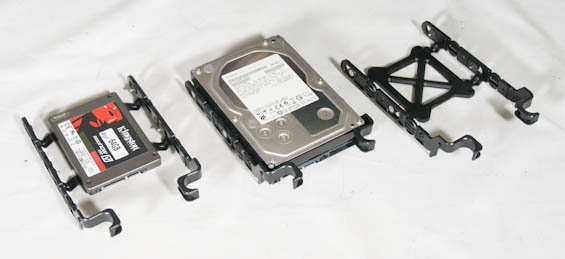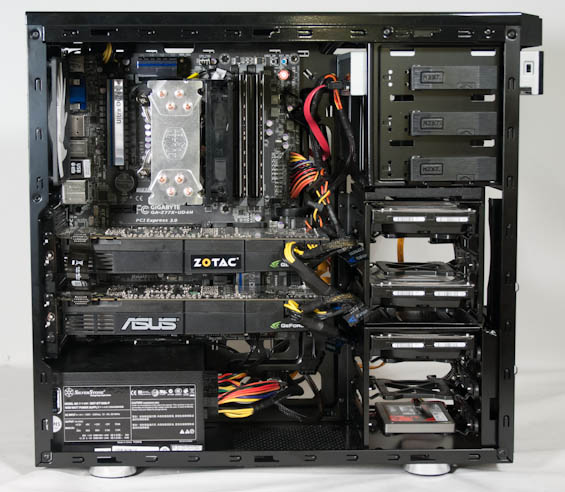NZXT H230 Silent Case Review
by Dustin Sklavos on September 13, 2013 12:00 PM EST- Posted in
- Cases/Cooling/PSUs
- NZXT
- ATX
- Case
My last few building experiences with NZXT cases have for the most part been fairly pleasant, and I was expecting a pretty breezy experience with the H230 as well. I got...most of that breezy experience, but this definitely could've been easier.
I'm assuming in a bid to get the production cost down, the H230 doesn't come with any standoffs or guides installed in the motherboard tray. That's not a tremendous sacrifice given the price segment we're competing in, but it's a small nuisance. Installing the test motherboard was easy enough, but where things went a little bit south was when it came to installing the drives.

The toolless mechanism NZXT uses for the 5.25" drive bays is actually pretty excellent and one of the better ones I've tested, but the 2.5"/3.5" drive trays are pretty terrible. They're incredibly flexible and they don't lock into the drive cages very well. If you install a 3.5" mechanical drive into one, that will stabilize it a little bit, but I found it was easy to make the tray with the 2.5" drive installed in it fall out of the case. This won't be a major problem for a case that's going to spend its life stationary with very little modification, but it's just so...shoddy.

Installing expansion cards and the power supply was very easy, but this is not a case designed for a tremendous amount of hardware. For some time I've felt like that was really the paradox of the ATX case; built to house the ATX board, but not really designed to handle a fully fleshed out system that takes advantage of the ATX spec. The result is that cabling proved to be a nightmare exacerbated heavily by the notched side panels; getting the rear panel back on is an exercise in frustration, as the spacing offered by NZXT isn't particularly generous. Also keep in mind that because the drive sleds enter from the back of the motherboard tray instead of the front, the handles on them can actually impede drive cabling.
I want to cut NZXT some slack for the H230's assembly, but these are issues that BitFenix already resolved a long time ago. The H230's internal design just isn't as progressive as competing cases; space could've been better utilized by bevelling the motherboard tray to allow for better cable channelling, and the drive sleds desperately need to be rethought. I'm also not sure we even needed the center drive cage, which undoubtedly takes away from NZXT's budget for the case design but doesn't seem to offer enough in exchange. If we're talking about a stripped down $69 case, what do we need more than three drive sleds for? If anything, bump the bottom cage up to four and call it a day.


_thumb.jpg)
_thumb.jpg)
_thumb.jpg)
_thumb.jpg)
_thumb.jpg)
_thumb.jpg)








29 Comments
View All Comments
ghitz - Monday, September 16, 2013 - link
Totally agree. 1/3rd of the space of common mITX cases is for the unnecessary large standard ATX PS. We need a new standard.Barbarossa - Sunday, September 15, 2013 - link
You might be right, but standard ATX mid towers and full towers still account for more than 3/4 of all case sales. Mini ITX and Micro ATX are growing, but slowly. It's a bit of chicken and egg scenario, though.Why build Micro ATX system if all the cool cases are ATX or larger? And then once you've already got the case and nothing's wrong with it, when you decide to upgrade, why limit yourself to Micro ATX or smaller?
Don't get me wrong - I think a lot of people are buying smaller PCs, and it's more and more each year, but the vast chunk of the DIY market is still buying standard or full tower cases.
-George @ Corsair
ghitz - Monday, September 16, 2013 - link
Most of them end up being mostly empty.Grok42 - Tuesday, September 17, 2013 - link
I've looked a lot for good stats on that the ATX, mATX and mITX market numbers. Very interesting to know it's still highly skewed toward ATX. I would love to read an article on where the market is and where it appears to be going. I certainly put 100% of the blame for the current emphsis on ATX at the feet of consumers and not companies like Corsair.Dentons - Friday, September 13, 2013 - link
Why not Fractal Design's R4?It's often discounted to the same price as this and was very well reviewed here. It's available from Amazon, Newegg, Microcenter and others. The Nanoxia is very difficult to recommend, not only because of its price, but because it's so hard to find a reseller stocking it.
meacupla - Friday, September 13, 2013 - link
My thoughts exactly.H230 looks exactly like a Define R4, except done worse in every conceivable way...
I would rather pay the extra $10~20 for an R4.
Touche - Saturday, September 14, 2013 - link
You really need to improve your noise floor. There are significant idle noise differences that aren't showing up in your tests.kevith - Saturday, September 14, 2013 - link
For a brief walkthrough and a quick summary, AT´s case reviews are absolutely fine, often with a subtle humor, nice to read.For the in-depth review with an extra emphasis on noise, go to SPCR.
EnzoFX - Saturday, September 14, 2013 - link
This. It's surprising actually since the rest of Anandtech is so thorough. Stark contrast.Barbarossa - Sunday, September 15, 2013 - link
That's easier said than done though. It's not like you can just add some foam to your walls and drop the sound level. Especially if you're reviewing from an apartment or townhouse or something.